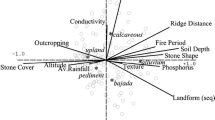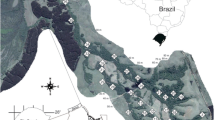Abstract
Hydroperiod is considered the primary determinant of plant species distribution in temperate floodplain forests, but most studies have focused on alluvial (sediment-laden) river systems. Few studies have evaluated plant community relationships in blackwater river systems of the South Atlantic Coastal Plain of North America. In this study, we characterzied the soils, hydroperiod, and vegetation communities and evaluated relationships between the physical and chemical environment and plant community structure on the floodplain of the Coosawhatchie River, a blackwater river in South Carolina, USA. The soils were similar to previous descriptions of blackwater floodplain soils but had greater soil N and P availability, substantially greater clay content, and lower soil silt content than was previously reported for other blackwater river floodplains. Results of a cluster analysis showed there were five forest communities on the site, and both short-term (4 years) and long-term (50 years) flooding records documented a flooding gradient: water tupelo community > swamp tupelo > laurel oak = overcup oak > mixed oak. The long-term hydrologic record showed that the floodplain has flooded less frequently from 1994 to present than in previous decades. Detrended correspondence analysis of environmental and relative basal area values showed that 27% of the variation in overstory community structure could be explained by the first two axes; however, fitting the species distributions to the DCA axes using Gaussian regression explained 67% of the variation. Axes were correlated with elevation (flooding intensity) and soil characteristics related to rooting volume and cation nutrient availability. Our study suggests that flooding is the major factor affecting community structure, but soil characteristics also may be factors in community structure in blackwater systems.
Similar content being viewed by others
Literature Cited
Abrahamsen, T. A. 1999. Trace elements in bed sediments and biota from streams in the Santee River Basin and Coastal Drainages, North and South Carolina, 1995–1997. U.S. Geological Survey, Water-Resources Investigations Report 99-4179.
Biondini, M. E., C. E. Bonham, and E. F. Redente. 1985. Secondary successional patterns in a sagebrush (Artenisia tridentate) community as they relate to soil disturbance and soil biological activity. Vegetatio 60:25–26.
Brady, N. C. 1984. The Nature and Properties of Soil. Ninth edition. McMillan Publishing Company, New York, NY, USA.
Burke, M. K. and J. L. Chambers. 2003. Root dynamics of bottomland hardwood forests under different hydrologic regimes. Plant and Soil 250:141–153.
Burke, M. K., S. L. King, and D. Gartner. 2000a. Soil and vegetation. p. 23–28.In M. K. Burke and M. H. Eisenbies (eds.) The Coosawhatchie Bottomland Ecosystem Study, a Report on the Development of a Reference Wetland. U.S. Department of Agriculture, Forest Service Southern Research Station, Asheville, NC, USA. General Technical Report SRS-38.
Burke, M. K., H. O. Liechty, and M. H. Eisenbies. 2000b. Above and belowground net primary production. p. 39–41.In M. K. Burke and M. H. Eisenbies (eds.) The Coosawhatchie Bottomland Ecosystem Study: a Report on the Development of a Reference Wetland. U.S. Department of Agriculture, Forest Service Southern Research Station, Asheville, NC, USA. General Technical Report SRS-38.
Burke, M. K., D. J. Raynal, and M. J. Mitchell. 1992. Soil nitrogen availability influences seasonal carbon allocation patterns in sugar maple (Acer saccharum). Canadian Journal of Forest Research 22:447–456.
Crawford, R. M. M. 1993. Plant survival without oxygen. Biologist 40:110–114.
Day, P. R. 1965. Particle fractionation and particle-size analysis. p. 545–567.In C. A. Black, D. D. Evans, J. L. White, L. E. Ensminger, F. E. Clark, and R. C. Dinauer (eds.) Methods of Soil Analysis. Part 1. American Society of Agronomy, Madison, WI, USA
Dollar, K. E., S. G. Pallardy, and H. G. Garrett. 1992. Composition and environment of floodplain forests of northern Missouri. Canadian Journal of Forest Research 22:1343–1350.
Dufrêne, M. and P. Legendre. 1997. Species assemblages and indicator species: the need for a flexible asymmetrical approach. Ecological Monograph 67:345–366.
Eisenbies, M. H. and B. G. Hughes. 2000. Hydrology. p. 10–13.In: M. K. Burke and M. H. Eisenbies (eds.) The Coosawhatchie Bottomland Ecosystem Study: a Report on the Development of a Reference Wetland. U.S. Department of Agriculture, Forest Service Southern Research Station, Asheville, NC, USA. General Technical Report, SRS-38.
Fitter, A. H. and R. K. M. Hay. 1987. Environmental Physiology of Plants, second edition. Academic Press, London, England.
Gemborys, S. R. 1974. The structure of hardwood forest ecosystems of Prince Edward County, Virginia, Ecology 55:614–621.
Hodges, J. D. 1998. Minor alluvial floodplains. p. 325–341.In M. G. Messina and W. H. Conner (eds.) Southern Forested Wetlands Ecology and Management. Lewis Publishers, Boca Raton, FL, USA.
Hughes, W. B., M. S. Croutch, and A. D. Park. 1989. Hydrogeology and saltwater contamination of the Floridan aquifer in Beaufort and Jasper Counties, South Carolina. State of South Carolina, Columbia, SC, USA. Water Resources Communication Report 158.
Hupp, C. R. 2000. Hydrology, geomorphology, and vegetation of Coastal Plain rivers in the southeastern USA. Hydrological Processes 14:2991–3010.
Hupp, C. and M. Shenning. 2000. Sedimentation. p 14–16.In M. K. Burke and M. H. Eisenbies (eds.) The Coosawhatchie Bottomland Ecosystem Study: a Report on the Development of a Reference Wetland. U.S. Department of Agriculture, Forest Service Southern Research Station, Asheville, NC, USA. General Technical Report, SRS-38.
Kellison, R. D., M. J. Young, R. R. Braham, and E. J. Jones. 1998. Major alluvial floodplains. p. 325–341.In M. G. Messina and W. H. Conner (eds.) Southern Forested Wetlands Ecology and Management, Lewis Publishers, Boca Raton, FL, USA.
Kirk, R. E. 1982. Experimental Design: Procedures for the Behavioral Sciences. Brooks/Cole Publishing Company, Wadsworth Inc., Belmont, CA, USA.
Kozlowski, T. T. 1997. Responses of woody plants to flooding and salinity. Tree Physiology Monograph 1:1–29.
Kramer, P. J. 1983. Water Relations of Plants. Academic Press, Inc., San Diego, CA, USA.
Larson, J. S., M. S. Bedinger, C. F. Bryan, S. Brown, R. T. Huffman, E. L. Miller, D. G. Rhodes, and B. A. Toughet. 1981. Transition from wetlands to uplands in southeastern bottomland hardwood forests. p. 225–272.In J. R. Clark and J. Benforado (eds.) Wetlands of Bottomland Hardwood Forests. Elsevier Publishing, Amsterdam, The Netherlands.
Lockaby, B. G. and M. R. Walbridge. 1998. Biogeochemistry. p. 149–172.In M. G. Messina, and W. H. Conner (eds.) Southern Forested Wetlands: Ecology and Management. Lewis Publishers, Boca Raton, FL, USA.
Maluk, T. L., T. A. Abrahamsen, and R. H. Day. 2000. Water quality. p. 17–19.In M. K. Burke, and M. H. Eisenbies (eds.) The Coosawhatchie Bottomland Ecosystem Study: a Report on the Development of a Reference Wetland. U.S. Department of Agriculture, Forest Service Southern Research Station, Asheville, NC, USA. General Technical Report, SRS-38.
McCune, B. and M. J. Mefford. 1997. PC-ORD. Multivariate Analysis of Ecological Data, Version 3.0. MjM Software Design, Gleneden Beach, OR, USA.
McKevlin, M. R., D. D. Hook, and A. A. Rozelle. 1998. Adaptations of plants to flooding and soil waterlogging. p. 173–203.In M. G. Messina and W. H. Conner (eds.) Southern Forested Wetlands: Ecology and Management. Lewis Publishers, Boca Raton, FL, USA.
McReynolds, R. D. and E. A. Hebb. 1990. Laurel oak. p. 677–680.In R. M. Burns and B. H. Honkala (eds.) Silvics of North America, Volume 2, Hardwoods. U.S. Department of Agriculture, Forest Service, Washington, DC, USA. Agriculture Handbook 654.
Mitch, W. J. and J. G. Gosselink. 2000. Wetlands, third edition. John Wiley and Sons, Inc. New York, NY, USA.
Murray, L. A., B. Eppinette, and J. H. Thorp. 2000. Geomorphology and soil survey. p 7–9.In M. K. Burke and M. H. Eisenbies (eds.) The Coosawhatchie Bottomland Ecosystem Study: a Report on the Development of a Reference Wetland. U.S. Department of Agriculture, Forest Service Southern Research Station, Asheville, NC, USA. General Technical Report SRS-38.
Okland, R. H. 1999. On the variation explained by ordination and constrained ordination axes. Journal of Vegetation Science 10: 131–136.
Parsons, S. E. and S. Ware. 1982. Edaphic factors and vegetation in Virginia Coastal Plain swamps. Bulletin of the Torrey Botanical Club 109:365–376.
Pearcy, R. W. and R. H. Robichaux. 1985. Tropical and subtropical forests. p. 278–295.In B. F. Chabot and H. A. Mooney (eds.) Physiological Ecology of North American Plant Communities. Chapman and Hall, New York, NY, USA.
Pritchett, W. L. 1979. Properties and Management of Forest Soils. John Wiley and Sons, New York, NY, USA.
Radford, A. E., H. E. Ahles, and C. R. Bell. 1968. Manual of the Vascular Flora of the Carolinas. The University of North Carolina Press, Chapel Hill, NC, USA.
Robertson, P. A., G. T. Weaver, and J. A. Cavanaugh. 1978. Vegetation and tree species patterns near the northern terminus of the southern floodplain forest. Ecological Monographs 48:249–267.
Robertson, P. A., M. D. Mackenzie, and L. F. Elliott. 1984. Gradient analysis and classification of the woody vegetation for four sites in southern Illinois and adjacent Missouri. Vegetatio 58:87–104.
SAS. 1987. SAS/STAT Guide for Personal Computers, Version 6 Edition. SAS Institute Inc., Cary, NC, USA.
Searle, S. R. 1971. Linear Models. John Wiley and Sons, New York, NY, USA.
Sharitz, R. R. and W. J. Mitsch, 1993. Southern floodplain forests. p. 311–372.In W. H. Martin, S. G. Boyce, and A. C. Echternacht (eds.) Biodiversity of the Southeastern United States/Lowland Terrestrial Communities. John Wiley and Sons, Inc., New York, NY, USA.
Solomon, J. D. 1990. Overcup oak. p. 681–685.In R. M. Burns and B. H. Honkala (eds.) Silvics of North America, Volume 2, Hardwoods. United States Department of Agriculture, Forest Service, Washington, DC, USA. Agriculture Handbook 654.
Soltanpour, P. N., J. B. Jones, Jr., and S. M. Workman. 1982. Optical emission spectrometry. p. 29–66.In A. L. Page R. H. Miller, and D. R. Keeney (eds.) Methods of Soil Analysis. Part 2. Chemical and Microbiological Properties. Soil Science Society of America, Inc., Madison, WI, USA.
Stanturf, J. A. and S. H. Schoenholtz. 1998. Soil and landforms. p. 123–147.In M. G. Messina and W. H. Conner (eds.) Southern Forested Wetlands: Ecology and Management. Lewis Publishers, Boca Raton, FL, USA.
Steele, R. G. D. and J. H. Torrie. 1960. Principles and Procedures of Statistics. McGraw-Hill Book Company, New York, NY, USA.
ter Braak, C. J. F. 1987-1992. CANOCO—A FORTRAN program for Canonical Community Ordination (version 2.1). Microcomputer Power, Ithaca, NY, USA.
Walkley, A. and I. A. Black 1934. An examination of the Degtjareff method for determining soil organic matter and a proposed modification of the chromic acid titration method. Soil Science 37:29–38.
Ward, J. H. 1963. Hierarchical grouping to optimize an objective function. Journal of the American Statistical Association 58:236–244.
Waring, R. H. 1991. Responses of evergreen trees to multiple stresses. p. 371–390.In H. A. Mooney, W. E. Winner, and E. J. Pell (eds.) Response of Plants to Multiple Stresses. Academic Press, Inc., San Diego, CA, USA.
Wharton, C. H., W. M. Kitchens, E. C. Pendleton, and T. W. Sipe. 1982. The ecology of bottomland hardwood swamps of the southeast: a community profile. U.S. Fish and Wildlife Service, Washington, DC, USA. FWS/OBS-81/37.
Author information
Authors and Affiliations
Rights and permissions
About this article
Cite this article
Burke, M.K., King, S.L., Gartner, D. et al. Vegetation, soil, and flooding relationships in a blackwater floodplain forest. Wetlands 23, 988–1002 (2003). https://doi.org/10.1672/0277-5212(2003)023[0988:VSAFRI]2.0.CO;2
Received:
Revised:
Accepted:
Issue Date:
DOI: https://doi.org/10.1672/0277-5212(2003)023[0988:VSAFRI]2.0.CO;2




